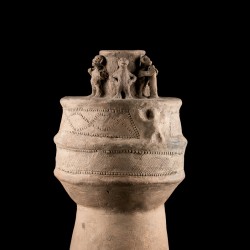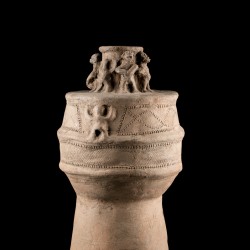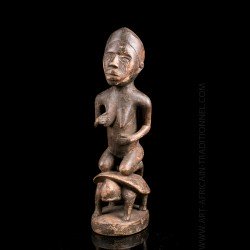























While Bakongo women made most pottery for domestic use, men produced ceramics for ritual use. Funerary stelae are defined by their tall, hollow, open, and cylindrical shape and are known as maboondo. They were intended for the elite and were placed on graves in the Boma region. This one does not show traces of prolonged outdoor use and is therefore very well preserved, especially at the level of small details.
While Europeans who visited the area in the 17th century described terracottas placed on Kongo tombs, recent studies indicate that the shape actually originates from the 19th century.
The architecture and iconography of these funerary monuments are often complex.
This diboondo (pl.maboondo) has figures on the upper part, in various positions. The middle section features incised lines creating an interlacing pattern similar to designs found on textiles in the region. As is often the case with other examples of these terracotta grave goods, the lower part is perforated and the top and base are open.
Adequate packaging will be carried out in order to best protect the part during transport.
Data sheet
You might also like

While Bakongo women made most pottery for domestic use, men produced ceramics for ritual use. Funerary stelae are defined by their tall, hollow, open, and cylindrical shape and are known as maboondo. They were intended for the elite and were placed on graves in the Boma region. This one does not show traces of prolonged outdoor use and is therefore very well preserved, especially at the level of small details.
While Europeans who visited the area in the 17th century described terracottas placed on Kongo tombs, recent studies indicate that the shape actually originates from the 19th century.
The architecture and iconography of these funerary monuments are often complex.
This diboondo (pl.maboondo) has figures on the upper part, in various positions. The middle section features incised lines creating an interlacing pattern similar to designs found on textiles in the region. As is often the case with other examples of these terracotta grave goods, the lower part is perforated and the top and base are open.
Adequate packaging will be carried out in order to best protect the part during transport.

